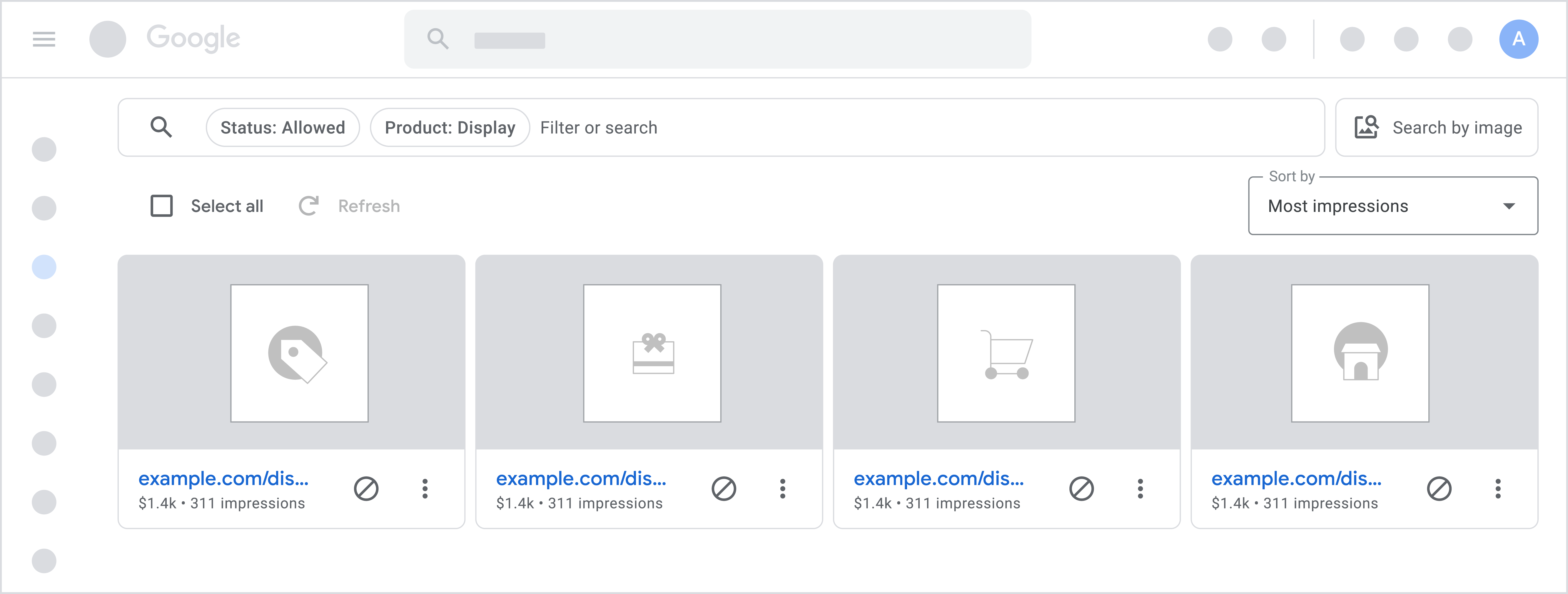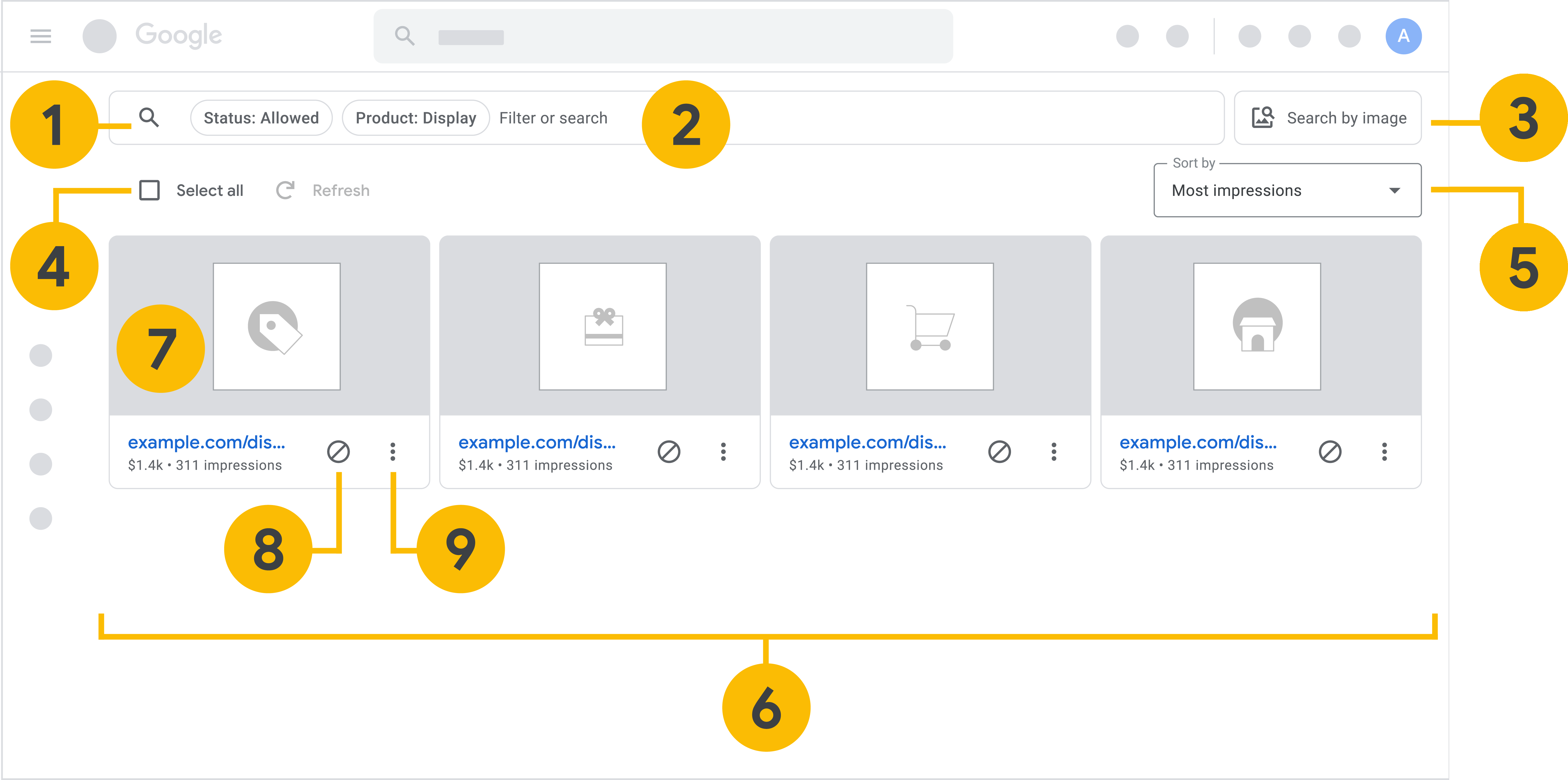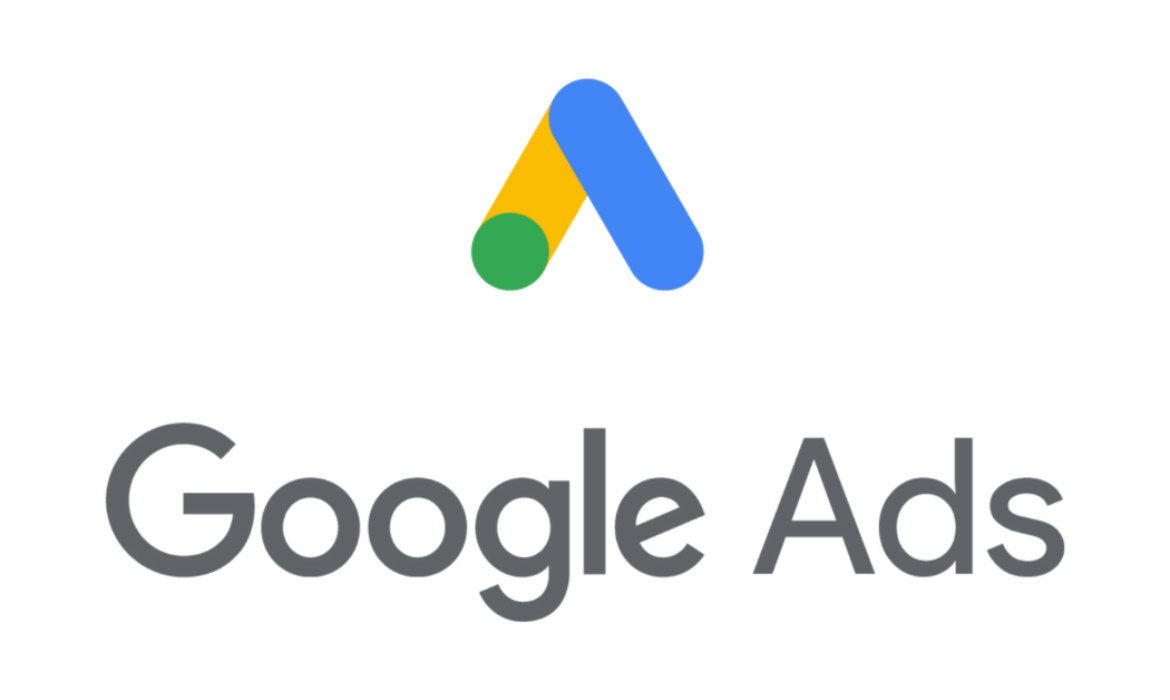Google Release Updated Ad Review Centre for its Ad Platforms
Google, the industry leader in search engines, has released an updated and new Ad Review Center for all of its platforms. These platforms consist of AdMob, Ad Manager, and AdSense. Advertisers will find it simpler to approve ads in the new Ad Review Center. The platform has undergone five significant updates, all of which are meant to enhance the advertising user experience. The modifications made focus on improving the user experience and giving advertisers a better, more effective way to manage their ads.
New attributes of the Upgraded Ad Review Centre

Image credit- Search Engine Round Table
Massive viewing area
Google’s recently updated Ad Review Centre has a better arrangement to make the most of the available space for ads. The features include a simplified and enhanced layout that increases the amount of viewable advertising space.
Enhanced, user-friendly filters
Google has added new advanced filters that have made it easier and quicker to choose between statuses like “Allowed” and “Blocked.”
Optimized Actions in Bulk
A clearly visible “Select All” button has been added by Google to improve user-friendliness for bulk actions. This implies that managing several ads pages at once is now easier and faster.
Easy-to-use image search
The increased visibility of “Search By Image” has made it easier for users to find targeted ads with more accurate search results. This is accompanied by a revised image selection dialog that now displays the prerequisites for image searches.
A more detailed view
With an expandable “Ad Info” feature that provides more metadata, Google’s upgraded platform now offers a more detailed view. To help users find ads that relate to the ones they are working on, this feature also adds a related ads tab.
Read More: Imagine Communications Join Forces with Google Ad Manager
Map functions

Image credit- Search Engine Round Table
- Filters: Refine the search results based on product, status, or reviews. One can go over them and allow or block advertisements as needed.
- Use a filter or search to find ads: One can look for specific ads using text search or you can use other filters like ad network, ad type, etc.
- Search by image: Upload a single PNG file that is no larger than 3MB to locate and block ads from their images.
- Choose all: Modify all of the ads on the current page in bulk by applying commands like block, and report, or mark as reviewed.
- Sort by: Decide on the order of the ads.
- Area for viewing ads: Examine each ad page separately. To navigate between pages and select how many ads you want on each page, use the controls at the bottom.
- Ad details can be viewed by clicking on an advertisement. This includes metadata, metrics, related ads, creatives in images or other formats, and more.
- Block an ad: You can easily block an advertisement if you find it objectionable.
- Additional actions: Take further steps, like blocking and reporting an advertisement or locating ads that are similar, etc.
Implications of the Updated Ad Review Centre
The purpose of these new features is to improve the effectiveness of ad management. It aims to make advertisers’ tasks less complicated and straightforward, possibly saving them significant time in the process. These new features have been linked to raising proficiency in promotion, completing the sponsor’s tasks, and potentially saving them a substantial amount of time all at once. The Ad Review Centre overview is a great resource for individuals looking for a thorough analysis of the latest updates and features.
Read More: Google Launches Google Ads Data Manager for First-Party Data
Meta to Offer Ad-Free Subscription Plans For European Users
Meta is thinking about releasing premium versions of Facebook and Instagram that would be ad-free for users in the European Union, according to The New York Times. These modifications are the result of ongoing regulatory review. It is evidence that, as a result of political decisions, the way Americans and Europeans view technology may diverge. In the European Union, Meta would keep providing free versions of Facebook and Instagram with ads. It is still unknown how much the apps’ commercial versions will be priced or when the company plans to release them.
Ads would not appear in the Facebook and Instagram apps for members. According to the New York Times, three individuals provided information on this matter while maintaining anonymity saying that the plans were classified. Providing customers with an alternative to the company’s ad-based services that depend on analyzing people’s data, may help Meta fight off privacy concerns and other criticism from EU regulators.
Read More: Meta Slams Apple Over ATT, Google Hit By Second U.K Anti Trust Investigation
Meta and the European Union
Offering users free social networking services and selling advertising space to businesses looking to reach their audience have been the two main focuses of Meta. The premium tier offering would go down as one of the most concrete cases to date of how businesses are being forced to rethink products. Furthermore, it would align with the changing data privacy laws and other governmental regulations, particularly in Europe. The EU and other European regulators have been at odds with Meta over alleged privacy breaches from its ad-tracking services and data transfers. In accordance with GDPR, Meta was fined $1.3 billion by Ireland’s Data Protection Commission for sending European users’ data to the United States. Recent data transfer agreements between the US and the EU have loosened limitations on social media sites.
The court for the European Union effectively forbade Meta from integrating user data gathered across its sites. It contained user-submitted data as well as information from Facebook, Instagram, and WhatsApp. Additionally, Irish regulators fined the corporation £390 million in January. They cited requiring users to consent to tailored adverts in order to use Facebook as the reason. In response, Meta has already started providing a way for users in the EU to opt out of receiving targeted advertising. Further, it was suggested that Meta would change it such that everyone in the area could opt-in.
Read More: Meta To Roll Out Web Version Of Threads, Granting User Requests
Meta’s commitment to EU expansion
The European Union is made up of 27 nations and about 450 million people. With the changing laws, regulations, and court decisions, consumers in the EU may start to witness distinct forms of consumer technology products. Meta has witnessed the willingness to develop paid memberships. The “Digital Markets Act,” another EU law focusing on advertising, will go into effect at the end of the year. According to Meta, allowing users to choose between using an ad-based service and accessing the paid versions of Facebook or Instagram could allay some of the worries of European regulators. Even if few users choose the paid version, offering it could benefit Meta’s interests in the area. Because of regulatory issues, Meta has yet to launch Threads, a competitor to X in Europe.
Future Outlook
Additionally, to overcome its difficulties in Europe, Meta is working to revive its operations. This comes after the worldwide economic unease slowed the expansion of its ad sales. Meta is currently focusing on the immersive virtual environment of the metaverse. Mark Zuckerberg, the company’s CEO is promoting the ambitious Metaverse project that is still in its infancy. The development of artificial intelligence technology and their integration into more Meta products are the executives’ main priorities. With this step, Meta is looking to empower its users with choice. The subscription plan is a significant move to strike the right balance between personalized experience and data privacy concerns in this evolving digital landscape.
Read More: Meta’s Horizon Worlds Expand to Mobile & Web Via Closed Beta Test
How Companies Like Snapchat Are Saying ‘NO’ To Targeted Ads
Do social media sites track you? In recent years, we have seen social media giants being fined multi-million dollars for breaching privacy.
A simple click, a like, a plain share, used in measuring the effectiveness of the advertising campaign kept users in the dark about how their data was being tracked. And all this began with the need for targeted ads.
Targeted Advertising is a means of advertising where consumers’ online activities are analyzed through cookies and data-mining, and in doing so, intrudes the privacy of the consumer.
Snapchat, the ‘on-the-go’ platform for users, started gaining in popularity amongst the top social network marketing platforms due to its organic, unfiltered, and real-life content.

(Image Credits: Michael Cohen/ Getty Images for New York Times)
Why is Snapchat is continuing to say NO to targeted Ads?
In October 2019 talks at GS, Snap Inc. Co-Founder and CEO Evan Spiegel aptly discussed how social media and digital marketing have transformed the way people communicate. He has rightly touched upon the debate surrounding the privacy of social media users.
In spite of NO targeted ads, why are companies keen to use Snapchat to market their products?
The answer lies in their statistics –
– By December 2019, Snapchat reached 218 million active daily users (Statista Report – 2019).
– Snapchat users, open the app over 20 times a day and spend an average of 30 minutes creating 3 billion snaps a day on the platform.
– Of the Snapchat users, the millennials and Generation Z, almost ¾ of them are under 25.
– Snapchat has more than 14 billion video views per day
– 18% of all social media users also use Snapchat.
– 76% of Snapchat users are also online shoppers.
What Marketing goals do marketers aim with Snapchat?
- Brand awareness
Almost 4 out of every 10 Snap chatters discover brands through Snapchat celebrity endorsements and online posts by expert bloggers or via vlogs (as per Global web index, July 2018).
- Lead Generation
For those trying to expand the top of your marketing funnel, Snapchat advertising lets you create ads within Ad Manager to drive users to download, form fill, or register.
- Driving local traffic to your website
Custom audiences are a success on Snapchat’s platform. The smaller the audience size, and the more specific the user types, it is easier to reach them. You can choose audience sizes and specific cities/countries to target.
- Increase Video Ads
Since ads are video-based, Snapchat provides a platform on its site for creating and editing video ads. This means without expensive outside or third-party editing services you can utilize the budgeted amount to increase the number of ads on Snapchat.
- New audiences
If your product can appeal to a younger demographic but you are unable to connect with them on other platforms, then Snapchat could be your best bet.
- Website views and conversions
A Snapchat ad encourages the user to swipe up, read more, or check out the website leading to a direct conversion through Snapchat advertising.
- App Installs and Engagement
Snapchat advertising is uniquely targeted to mobile users in a way that Facebook, Twitter, Pinterest, and others can relate to but never quite imitate. The target audience is only a touchscreen away from the app store – or a tap away from a deep link placing them right where you want them in-app.
What are the available ad formats on Snapchat?
Snapchat offers three different kinds of ad formats.
i. Snap Ads: Snap Ads appeal to the widest range of advertisers. They come in three forms. Long-form video, website traffic, and app install.
ii. Filters: Filters show up when you take photos on the app. They are designed for brick-and-mortar locations or for large live events.
iii. Lenses: Like filters, lenses show up on selfie shots and are best reserved for wide-spread brand-awareness campaigns.
How will my marketing campaign work on Snapchat if there are no targeted ads?
Like on every social media platform test the waters. The advantages of Snapchat are,
a. Assess if your target market uses Snapchat
Depending on your product/service and the profile of your users, you can have a fair indication, if your target audience uses Snapchat. Or how about asking your Twitter followers if they are on Snapchat? Don’t simply conclude basis demographics that your product/service may not be fit to be marketed on Snapchat. CNN would not be on Snapchat if it thought youngsters are not really interested in world news.
b. Compare Snapchat data to your own demographic data on current customers
According to eMarketer, 6.4% of Snapchat users are going to be between the ages of 45 and 54 which is up more than 2% from 2017 and will be growing in numbers. Further 70% of users are women. Of these, 71% are less than 25 years old, and 38% of them enjoy an income of over $50,000.
Once your product fits the age, gender and lifestyle demographics of your current audiences, Snapchat may turn out to be a good place for your product.
c. Spend a small amount
As per Hootsuite, filter-based Snapchat Ads are as low as $5. The price only increases with the size of the reach. For example, Hootsuite found that an entire city cost $3,000 for them, while the immediate area around their office was only $13 for two days. This gives a first time advertiser to try out the platform without major spending
Conclusion
One of the reasons for the stupendous growth of Snapchat is the position it holds in terms of augmented reality. (Just launched Snapchat’s AR filters that are turning the floor into lava). Universal Pictures wasn’t the first company to place an advertisement on Snapchat, but it was the first to pay Snapchat for an ad. Taco Bell recently told Adweek.com that about 80 percent of its followers open its snaps and 90 percent of those people view the messages in their entirety. It’s easy to understand why brands might be willing to overlook some of Snapchat’s weaknesses when you compare it to the low single-digit engagement averages for organic posts.




